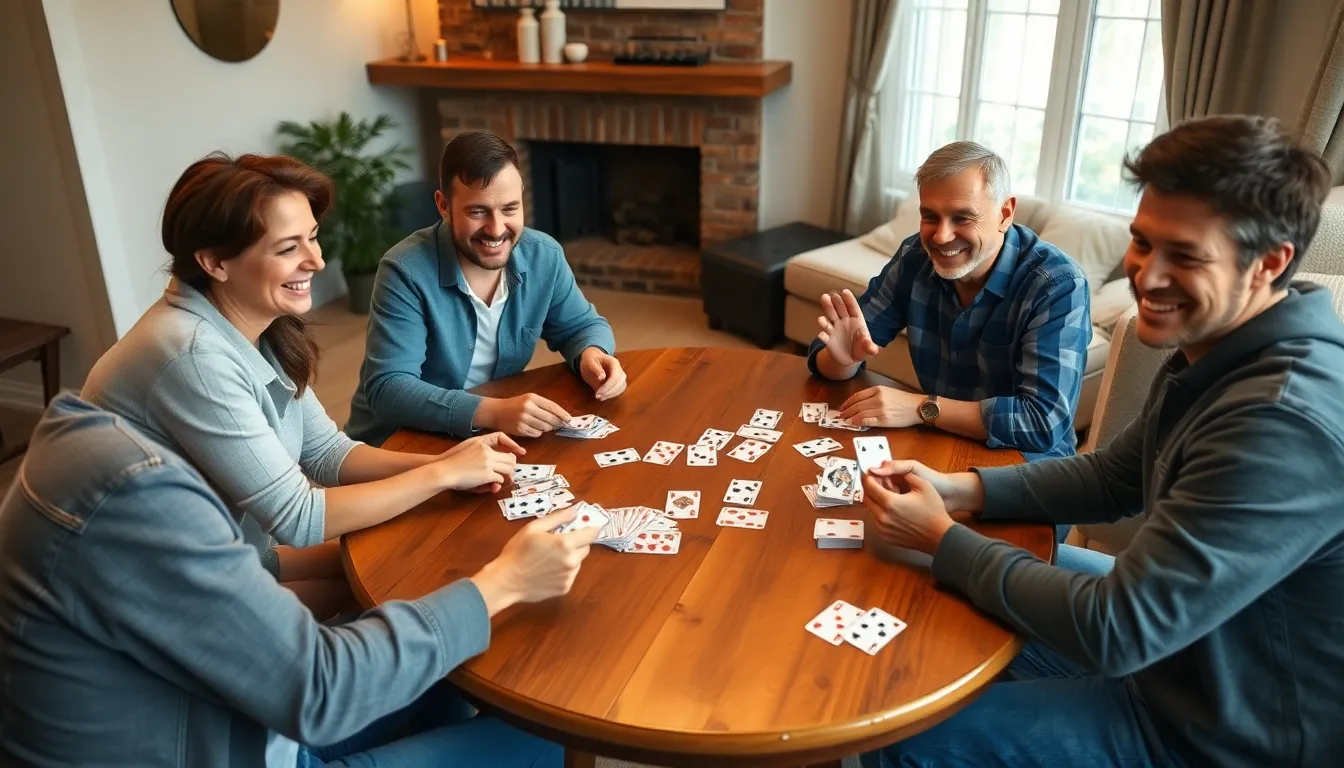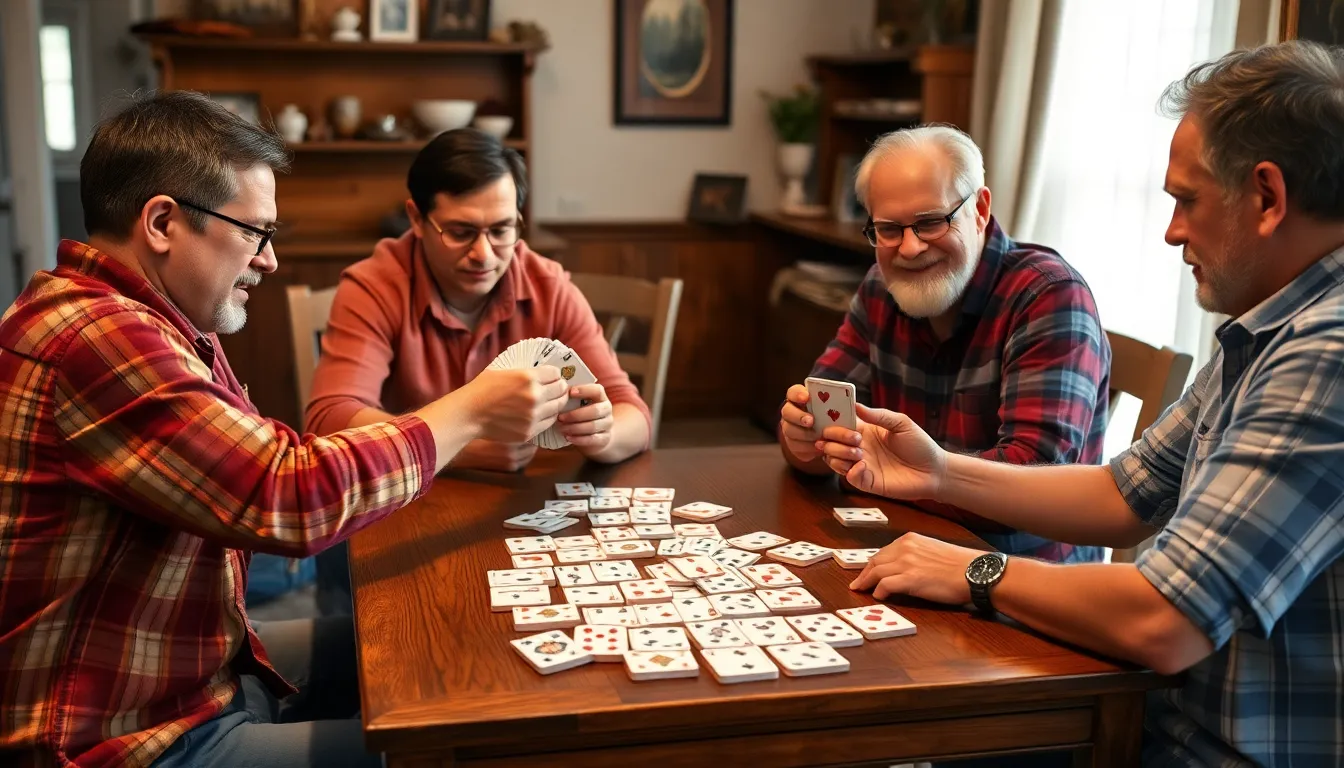War is a classic card game that’s simple yet exciting, making it perfect for players of all ages. With just a standard deck of cards, it brings friends and family together for hours of fun and friendly competition. The game’s straightforward rules allow anyone to jump right in, making it a popular choice for gatherings or quiet afternoons.
Overview of War Card Game
War is a classic card game known for its ease of play and engaging style. Players enjoy its competitive spirit and accessibility.
Objective of the Game
The objective of War is to win all the cards from opponents. Players compare the top cards of their decks during each turn, and the player with the higher card collects both cards, adding them to their pile. In case of a tie, players engage in a “battle,” where additional cards are drawn, adding excitement to the gameplay.
Number of Players
War accommodates 2 to 4 players. With more than two players, the game remains competitive, and the dynamics shift as players strategize against multiple opponents. It fosters interaction while keeping the gameplay fast-paced and enjoyable.
Setting Up the Game


Setting up the game of War is straightforward, requiring minimal preparation. Players gather the necessary materials and perform a shuffle before dealing out cards.
Required Materials
- Standard Deck of Cards: Use a 52-card deck, excluding jokers. Many brands produce decks with various designs, all suitable for the game.
- Players: Two to four players can participate. This flexibility enhances competitiveness and social interaction.
- Flat Surface: A table or flat surface allows players to lay down cards and keep their decks organized.
Shuffle and Deal
- Shuffle the Deck: Players should shuffle the deck thoroughly to ensure a random distribution of cards. This step adds excitement and unpredictability.
- Deal the Cards: Deal the entire deck evenly among all players. Each player receives an equal number of cards, typically forming a face-down stack. If the number of cards isn’t divisible by the number of players, some players may receive one card more than others.
Game Rules and Gameplay
The game of War follows simple rules that make it easy for players to enjoy. Understanding the basic mechanics ensures a smooth experience for all participants.
Basic Rules
- Players split a standard 52-card deck evenly among themselves.
- Each player places their stack face down without looking at the cards.
- On each turn, players flip the top card and reveal it simultaneously.
- The player with the higher card wins both cards and places them at the bottom of their stack.
- Aces rank the highest, followed by Kings, Queens, and so on, down to 2s.
- In case of a tie where both cards are equal, a “battle” occurs.
Winning a Round
- Players engage in a battle after a tie: each player draws three additional cards face down, followed by one card face up.
- The player with the higher face-up card wins all ten cards involved in the battle.
- If the face-up cards are again equal, another battle occurs, continuing until there is a victor.
- Players repeat this process until one player emerges victorious, collecting all cards in play.
End of the Game
- The game concludes when one player collects all the cards from the other participants.
- Players can choose to play multiple rounds, tracking wins to determine an overall champion.
- An alternative approach allows players to set a time limit, with the player holding the most cards at the end declared the winner.
- Players can vary the game’s rules or introduce new twists to keep gameplay fresh and engaging.
Strategy Tips for Winning
Winning at War requires not only luck but also an understanding of card values and effective play strategies. Here are some tips to enhance your gameplay.
Card Values
Understanding card values is essential in War. The ranks of the cards, from highest to lowest, are as follows:
- Ace
- King
- Queen
- Jack
- 10
- 9
- 8
- 7
- 6
- 5
- 4
- 3
- 2
Knowing this order helps players anticipate outcomes in battles. The Ace, being the highest card, consistently provides an advantage over lower-ranked cards, while the 2, being the lowest, often faces elimination swiftly. Recognizing these values can guide decisions in tricky moments during the game.
Play Strategies
Implementing strategic approaches can significantly improve winning odds. Here are key strategies for players to consider:
- Remain Calm: Staying composed during battles aids in rational thinking and decision-making.
- Observe Opponents: Noticing patterns in opponents’ gameplay may reveal tendencies and inform future moves.
- Aim for Speed: Quickly revealing cards can maintain excitement and momentum, increasing the chances of winning draws.
- Utilize Battles Wisely: During ties, draw additional cards methodically to increase winning possibilities, especially when ahead in cards.
- Track Success: Keeping score across multiple rounds helps identify strengths and weaknesses, allowing adjustments for future games.
Applying these strategies can elevate the gaming experience, making War not just a game of chance, but also one of skill.
War is a timeless card game that combines simplicity with excitement. Its easy-to-follow rules and competitive nature make it a favorite for players of all ages. Whether it’s a family gathering or a casual hangout with friends, War brings people together in a fun and engaging way.
With just a standard deck of cards and a few players, anyone can dive into the action. The thrill of battles and the unpredictability of card draws create an atmosphere of anticipation. By incorporating strategic elements and adapting the rules, players can elevate their experience and enjoy countless hours of entertainment.
Ultimately, War is more than just a game of chance; it’s a chance to connect and create lasting memories. So gather some friends, shuffle the deck, and let the battles begin.
